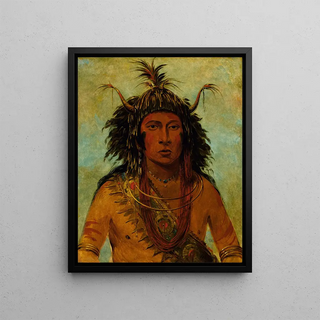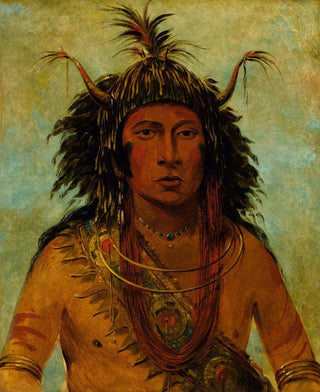Art print | Say-Say-Gon Hail Storm War Chief - George Catlin


View from behind

Frame (optional)
In the fascinating world of American art, the art print "Say-Say-Gon Hail Storm Chef de guerre" by George Catlin stands out for its ability to capture the essence of Native American cultures at a time when their existence was often at risk. This vibrant and emotionally charged art print immerses us in the traditions and struggles of indigenous peoples. Through this art print, the artist manages to convey an atmosphere of heroism and spirituality, inviting us to explore a world rich in history and symbolism. The work not only evokes the beauty of landscapes but also the complexity of human relationships and the beliefs that shape the identity of these communities.
Style and uniqueness of the art print
George Catlin's style is recognizable by its realistic approach and its palette of bright colors. In "Say-Say-Gon Hail Storm Chef de guerre," the artist uses pictorial techniques that highlight the textures and details of traditional costumes. The faces of the characters are full of character, each telling a unique story. Catlin succeeds in creating a dynamic between the subject and the environment, illustrating the symbiosis between man and nature. Elements of the composition, such as the movement of clouds or the posture of the figures, add an almost cinematic dimension to the art print, evoking a sense of movement and life. This piece is not just a visual representation; it is a window into a world in full transformation, where every brushstroke testifies to the cultural richness of Native American nations.
The artist and his influence
George Catlin, 19th-century painter and writer, is often considered a pioneer of ethnographic art. His commitment to documenting the lifestyles of indigenous peoples is unprecedented. Through his travels across the United States, he met many tribes and managed to capture their essence in his works. Catlin was not just a painter; he was also a passionate advocate for the rights of Native Americans, campaigning for their recognition and preservation. His influence endures today, inspiring generations of artists and historians to explore

Matte finish

View from behind

Frame (optional)
In the fascinating world of American art, the art print "Say-Say-Gon Hail Storm Chef de guerre" by George Catlin stands out for its ability to capture the essence of Native American cultures at a time when their existence was often at risk. This vibrant and emotionally charged art print immerses us in the traditions and struggles of indigenous peoples. Through this art print, the artist manages to convey an atmosphere of heroism and spirituality, inviting us to explore a world rich in history and symbolism. The work not only evokes the beauty of landscapes but also the complexity of human relationships and the beliefs that shape the identity of these communities.
Style and uniqueness of the art print
George Catlin's style is recognizable by its realistic approach and its palette of bright colors. In "Say-Say-Gon Hail Storm Chef de guerre," the artist uses pictorial techniques that highlight the textures and details of traditional costumes. The faces of the characters are full of character, each telling a unique story. Catlin succeeds in creating a dynamic between the subject and the environment, illustrating the symbiosis between man and nature. Elements of the composition, such as the movement of clouds or the posture of the figures, add an almost cinematic dimension to the art print, evoking a sense of movement and life. This piece is not just a visual representation; it is a window into a world in full transformation, where every brushstroke testifies to the cultural richness of Native American nations.
The artist and his influence
George Catlin, 19th-century painter and writer, is often considered a pioneer of ethnographic art. His commitment to documenting the lifestyles of indigenous peoples is unprecedented. Through his travels across the United States, he met many tribes and managed to capture their essence in his works. Catlin was not just a painter; he was also a passionate advocate for the rights of Native Americans, campaigning for their recognition and preservation. His influence endures today, inspiring generations of artists and historians to explore






